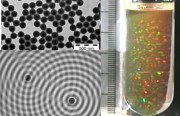small angle neutron scattering
(SANS)
Small angle neutron scattering experiments were performed on the instruments D11 and D22 at the Institute Laue-Langevin (ILL) in Grenoble (France). Neutron wavelengths have a size order lying in the lowest range of nanometers (D22: 0.3 - 4 nm). Thus the examination of colloids is possible on length scales which are inaccessible with the methods of light scattering. So, small angle neutron scattering enables the observation of the internal structure of micronetwork-particles. In principle the setup of a small angle experiment is the same as for light scattering. It consists of a source (Q), a sample holder (P) and a detector (D). In the small angle scattering the deflection of the scattered beam from the horizontal plane is called height m. The distance between probe and detector, the height m of the scattered beam and the resulting scattering angle characterize the scattering geometry.

The monochromator (M) and the collimator (K) belong to the elements of the instruments D11 and D22.
The collimation determines the apparent origin of neutrons. Different mobile neutron ladders will be introduced into the beam. This leads to the realization of different collimation distances. To monochromate the neutron beam a mechanic velocity selector is used. It consist of a rotating cylinder with helical gaps. Because of the constant velocity of rotation only neutrons with a specific wavelength are able to pass the cylinder.
.

